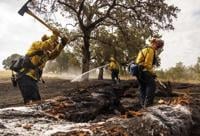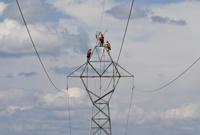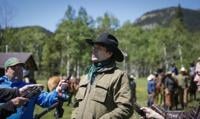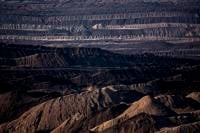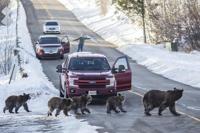TOMS RIVER, N.J. (AP) — In hindsight, it's clear that something was very wrong in this suburban town at the Jersey Shore, where many people worked at or lived near a chemical company that was flushing toxic waste into waterways and burying it in the ground.
Men would come home from the plant, which made dyes and resins, and their perspiration would be the color of the dye with which they worked.
Children swam in the local river, coming up for air in the midst of milky white froth that floated on the water's surface. There seemed to be fewer fish than would be expected; some that were there appeared to be transparent, and others had sores.
And children were being diagnosed with cancer at higher-than-normal rates.
It wouldn't be until many years later that the truth would come out: Ciba-Geigy Chemical Corp., the town's largest employer, had been flushing chemicals into the Toms River and the Atlantic Ocean, and burying 47,000 drums of toxic waste in the ground. This created a plume of polluted water that has spread beyond the site into residential neighborhoods. It made the area one of America's most notorious Superfund sites, joining the list of the most seriously polluted areas in need of federally supervised cleanup.
The state health department found that 87 children in Toms River, which was then known as Dover Township, had been diagnosed with cancer from 1979 through 1995. A study determined the rates of childhood cancers and leukemia in girls in Toms River “were significantly elevated when compared to state rates.” No similar rates were found for boys.
The company, which was charged criminally, has paid millions of dollars in fines and penalties on top of the $300 million it and its successors have paid so far to clean up the 1,250-acre (506-hectare) site — an ongoing effort with no end in sight.
Now, New Jersey has reached a settlement with the site's current owner, BASF Corp., to address damage to natural resources at the site. And residents of Toms River, where “cancer cluster” is part of the local vocabulary and bottled water is the only type many will drink, are not happy with the deal, describing it as woefully insufficient.
The settlement must still be finalized by the state Department of Environmental Protection.
The agreement commits BASF — which owns the site as the corporate successor to Ciba-Geigy — to restore wetlands and grassy areas; create walking trails, boardwalks and an elevated viewing platform; and build an environmental education center. In addition to doing that work, whose cost has not yet been calculated by the state or the company, BASF will pay the state $100,000 and be allowed to continue to host an array of solar panels on part of the site.
Mayor Maurice Hill said Toms River is known for two main things: winning the Little League World Series in 1998, and the Ciba-Geigy Superfund site, blamed by many residents for the town's elevated level of childhood cancer cases.
He called the saga “an open wound for Toms River and a great community pain."
The mayor and others said the settlement does not do nearly enough to compensate Toms River and its residents for the decades of pollution and illness they have endured.
Hill complained the deal was negotiated without any local input, wants 250 acres (101 hectares) of the site that BASF could develop to instead be given to the township, and says a contingency fund to address any future undiscovered contamination should be part of it.
At a public meeting on the proposal hosted Wednesday night by a local environmental group, resident after resident told of the pain of losing loved ones or friends — and not knowing that the water they were swimming in and drinking might make them sick.
“I have a friend that has five kids, and four out of the five have cancer,” said Gloria Baier, whose father recently died from cancer. "I swam in that water. There was this muck that was whitish and would float on top of the water. You'd pop your head up sometimes into this.
“I remember looking down and saying, ‘Why does that fish look transparent to me?’” she said.
“You could see fish that had sores on them,” added Jeff Fackenthal. “You could see that it wasn't right.”
Summer Bardier's uncle worked at the plant.
“He would come home in the summer and he would sweat the color of the dye he was working with,” she said. “He was contaminated, and he was contaminating his children.”
Michael Matthews lost his best friend to a rare childhood cancer at age 12. Another friend died of the same illness.
DEP Commissioner Shawn LaTourette said the settlement is not designed to punish anyone, and emphasized that BASF remains obligated to completely finish cleaning up the site under the supervision of the federal Environmental Protection Agency.
In 1992, Ciba-Geigy paid $63.8 million to settle criminal charges that it illegally disposed of hazardous waste, and it and two other companies reached a $13.2 million settlement with 69 families whose children were diagnosed with cancer.
BASF took over the site in 2010, two decades after plant operations ceased, and emphasizes that it did nothing to contaminate the site.
The current proposed settlement aims to restore natural resources that are the property of all New Jerseyans to a condition where those resources can be used again, LaTourette said.
“That's what this is about,” he said. “It's not the same as their obligation to clean up the site.”
He said people instinctively want to put a dollar value on things, which is why the benefits of this settlement can seem hard to grasp.
“BASF’s primary goal is to restore the site to meet regulatory standards that are protective of human health and the environment,” said company spokesperson Molly Birman. “We look forward to implementing the restoration projects and opening new possibilities to encourage recreation, learning and community engagement at the site.”
But many residents said they won't go anywhere near the site even after remediation work is completed. One man who attended a public hearing on the settlement Wednesday said he won't even drive past the site with his car window rolled down.
“This might be a really great park some day,” added environmental activist Janet Tauro. “Maybe in 100 years?”
Diane Salkie, a project manager with the EPA who has been overseeing the cleanup since 2011, said a plume of contaminated groundwater is 40% smaller than it originally was, but it still extends underneath some residential communities.
BASF is pumping almost a million gallons a day from the ground, treating it to remove contaminants, and discharging it back into the ground. About 341,000 cubic yards (261,000 cubic meters) of soil has been dug up and treated at the site — enough to fill 136,400 pickup truck beds.
Salkie said that in 1996, it was estimated the cleanup would take 30 years — which would end in 2026. Last week, she said, “I don't think we'll get there. It's just so hard to set a timeline.”
Christine Girtain, a science teacher at one of Toms River's high schools and the current New Jersey State Teacher of the Year, said the environmental education center should present the full history of Ciba-Geigy's deliberate pollution of the site, and honor those who died as a result of it.
“They need to know the names of the people who died because of that pollution,” she said. “We lost a lot of children because of Ciba.”
BASF is “open to including the site’s environmental history as part of the educational facility,” Birman said.
___
Follow Wayne Parry on Twitter at












